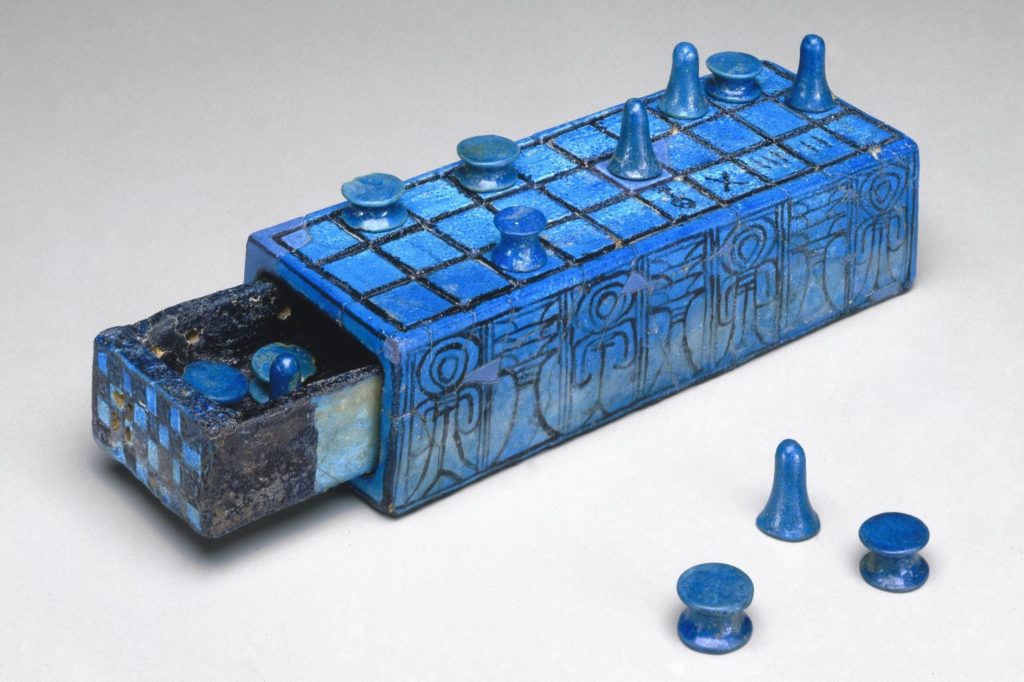The Game of Passing
 2 Players 2 Players |
 Course Course |
 Chance Chance |
 Complex Complex |
 Long Long |
History

Senet (from ancient Egyptian znt, meaning “to pass”; Coptic ⲥⲓⲛⲉ /sinə/, “to pass, afternoon”) is one of the oldest known board games, with a documented history of over 5,000 years. Related boards have been discovered in Predynastic and 1st Dynasty burials (3500-3100 BCE) at Abydos and Saqqara. The first certain representation dates from around 2620 BCE, in the mastaba of Hesy-Re, a high official of the 3rd Dynasty under King Djoser.
Evolution from secular game to mystical ritual
Old and Middle Kingdoms (c. 2686-1650 BCE). During the Old Kingdom, senet was exclusively entertainment. Tomb representations, such as that of Pepi-ankh at Meir (c. 2300 BCE), show players competing with strategic commentary revealing a positional game where experts could move their seven pieces ahead of their opponent’s. Movement follows a boustrophedon pattern (direction reversed with each row), a unique characteristic of senet. The last five squares bear secular inscriptions: “good,” “bad,” and the sequence 3-2-1, which determines exit movements and would never change in 3,000 years.
New Kingdom: the religious transformation (18th Dynasty, 1570-1293 BCE). This period marks a complete revolution. The game changes from seven to five pieces per player and is integrated into wooden boxes with drawers, often manufactured specifically for tombs with funerary offering formulae inscribed. More fundamentally, under Hatshepsut (c. 1498 BCE), the sequence 3-2-1 becomes three birds, two men, one man, whilst the “bad” transforms into an aquatic trap. Under Seti I (1291-1279 BCE), the “men” become “gods.”
Tomb representations evolve radically: senet disappears from daily scenes to appear in a religious context, often linked to the Book of the Dead. Players no longer compete against each other but against an invisible adversary—their own soul.
The cartography of the afterlife
By the end of the 18th Dynasty (1293 BCE), the board becomes a true simulation of the nocturnal journey with the god Re through the 12 regions of the afterlife (corresponding to the 12 hours of night). Each square corresponds to specific deities and events: square 1 “House of Thoth” announces the deceased’s arrival at the divine tribunal; square 12 represents the constellation of Orion/Osiris; square 15 “House of Life that Repeats” (frog, symbol of resurrection) offers an additional turn; square 27 “Waters of Chaos” constitutes the ultimate trap where pieces are definitively lost, like sinful souls drowned in the primordial waters.
The final square (30) of Re-Horakhty represents the solar god in his form as the rising sun at dawn. Moving all one’s pieces there signifies achieving mystical union with the solar god whilst still alive, guaranteeing survival of the afterlife trials before even dying. This discovery reveals that the Egyptians believed they could actively influence the judgement of their soul—a belief revealed by Peter Piccione’s research.
Late Period (20th Dynasty, c. 1185-1075 BCE). Religious evolution reaches its peak with boards entirely decorated with religious motifs, accompanied by ritual texts where the player narrates in the first person the journey of their pieces through the afterlife. Paradoxically, secular forms persist simultaneously, testifying to the remarkable coexistence of two traditions: recreational gaming and its mystical version.
Expansion and decline
Senet spread beyond Egypt, notably to Cyprus towards the end of the third millennium, testifying to Egyptian cultural influence. Despite 3,000 years of evolution, the game retains remarkable structural stability.
Decline begins during the Roman period, although graffiti at Dendera suggest residual persistence. The game also survives in late literature: in the tale of Setne Khamwas and Si-Osire (Roman period), the deceased Naneferkaptah challenges Setne to a board game for a mysterious book. Although senet is not named, the mystical stakes, funerary context, and religious implications of the challenge clearly evoke this game, testifying to its persistence in the Egyptian imagination.
The exact rules have not survived, but several reconstructions have been proposed since Gustave Jéquier’s pioneering work in the 1930s.
Game rules
Equipment and setup
- A game board whose surface is divided into 30 squares arranged in three parallel rows of 10 squares each. The 15th, 26th, 27th, 28th, 29th, and 30th squares are decorated with drawings and have particular meanings.
- Two sets of 7 pieces each in different colours or shapes—that is, 7 identical pieces per player (During the New Kingdom, it appears the game was preferably played with 5 pieces per player).
- 4 sticks with one decorated face (or painted in a certain colour) and one “neutral” face (natural colour or painted in another colour).
The pieces are placed on the first 14 squares of the game in alternating fashion: pieces of one colour on the odd-numbered squares, pieces of the other colour on the even-numbered squares.
 The square marked with the ankh sign of life (15th square) is the starting square.
The square marked with the ankh sign of life (15th square) is the starting square.
Objective
To move all one’s pieces along a given route, then remove them from the game, whilst attempting to slow the progress of the opponent’s pieces. The first player to remove all their pieces from the game wins the match.
Moving the pieces
The pieces progress on the board following an S-shaped path (from right to left on the first row, then from left to right on the second, and finally from right to left again on the last row).

Pieces always move forwards according to the results obtained by throwing all four sticks simultaneously into the air and examining their combination once they have fallen. The faces turned upwards are counted as follows:
- One decorated surface: 1 point and play again
- Two decorated surfaces: 2 points and pass the turn
- Three decorated surfaces: 3 points and pass the turn
- Four decorated surfaces: 4 points and play again
- Four “neutral” surfaces: 5 points and play again
The number of points obtained can be played with any piece of one’s colour, but cannot be split between several pieces.
One is permitted to jump over pieces (one’s own or the opponent’s), except when three opposing pieces occupy adjacent squares (see below). Occupied squares also count towards the number of advancement points.
Two pieces, even if they are the same colour, can never occupy the same square.
Making the opponent retreat
A piece can never be removed from the game. There is therefore no capturing of opposing pieces, but one can make one’s opponent retreat: when a piece lands on a square occupied by an opposing piece, the latter must retreat to the square from which the attacker came (the pieces therefore exchange positions).
Two pieces of the same colour in two adjacent squares form a small block: they cannot be taken. The opposing player therefore cannot make them retreat and take one of these two places. They must then move another of their pieces or, if this is impossible, stay put and pass their turn.
Three pieces of the same colour in succession form a large block; not only do they protect each other, but they also cannot be passed by an opposing piece. They therefore form a wall for the opponent (without preventing pieces of their own side from advancing).
This blocking situation is one of the tactical foundations of the game, forcing the player to retreat one of their pieces if they cannot advance any other (this game of exchanging positions and blocking can already take place behind the starting square, before the pieces are even engaged on the course).
Gameplay

The players take turns throwing the sticks. The person who obtains a throw of “1” begins. They move the piece positioned on the 14th square to the ankh starting square and thus take the pieces of the colour of this piece.
Stopping on the ankh starting square is mandatory. Each piece must therefore, through one or more throws of the sticks, land on the starting square before being able to begin the course. This square is protected, so the piece cannot be dislodged by the opponent. By remaining on this square, a piece can therefore block the entry into play of other pieces.
Subsequently, the throw of the sticks indicates the number of advancement points that the player can assign to one of their pieces of their choice.
As long as a player obtains a “1,” “4,” or “5,” they can play again, but as soon as they obtain a “2” or “3,” they play and pass the turn to their opponent.
The players advance their pieces in turn, according to the number of points obtained, trying to overtake those of the opponent whilst seeking to block them or make them retreat.
If a player cannot execute the number of points obtained by throwing the sticks, they must move backwards. Every throw that does not allow forward movement must be used to retreat by the same number of squares, provided they thus land on a square they do not already occupy.
If, in this way, one lands on an opposing piece, one must move it (and therefore advance it) to the square from which it came.
If, despite this, no movement is possible, the player passes their turn.
Special squares at the end of the course
 House of Happiness (26th), marked nefer (“good”), is a “luck” square where the piece cannot be taken. A throw of “5” allows the piece to leave the game immediately. On a throw of “1,” the player has the right to throw the sticks again (so as not to land on the “House of Water”).
House of Happiness (26th), marked nefer (“good”), is a “luck” square where the piece cannot be taken. A throw of “5” allows the piece to leave the game immediately. On a throw of “1,” the player has the right to throw the sticks again (so as not to land on the “House of Water”).
 House of Water (27th), marked with the sign mu (“water”), is a trap: any piece falling into this square will be sent back to the ankh starting square: the “House of Rebirth” or, if this is occupied, to the first empty square before the starting square. The player can also choose to remain in this square until a throw of “4” allows them to leave the game. However, they are then forbidden to move another of their pieces on the board.
House of Water (27th), marked with the sign mu (“water”), is a trap: any piece falling into this square will be sent back to the ankh starting square: the “House of Rebirth” or, if this is occupied, to the first empty square before the starting square. The player can also choose to remain in this square until a throw of “4” allows them to leave the game. However, they are then forbidden to move another of their pieces on the board.
 House of the Three Truths (28th), symbolically bears the number 3: only a throw of “3” allows the piece to leave the game.
House of the Three Truths (28th), symbolically bears the number 3: only a throw of “3” allows the piece to leave the game.
 House of Re-Atum (29th), symbolically bears the number 2: only a throw of “2” allows the piece to leave the game.
House of Re-Atum (29th), symbolically bears the number 2: only a throw of “2” allows the piece to leave the game.
 House of Horus (30th): only a throw of “1” allows the piece to leave the game.
House of Horus (30th): only a throw of “1” allows the piece to leave the game.
Furthermore, the “Happiness,” “Three Truths,” and “Re-Atum” squares protect the pieces they shelter; they cannot be attacked, even if they are isolated, and can remain there without time limit.
Further reading
- C. Breyer, Jeux et jouets à travers les âges. Histoire et règles de jeux égyptiens, antiques et médiévaux, Bruxelles, éditions Safran, 2010.
- P. Piccione, In Search of the Meaning of Senet, 1980
- Article on Senet, on Wikipedia.
- Educational experiment using senet to teach probability, described in an article by the Institute for Research on Mathematics Teaching (IREM) of Lille: Le senet, de l’Egypte ancienne à nos cours de mathématiques, François Martini, Lisa Rougetet, January 2019.